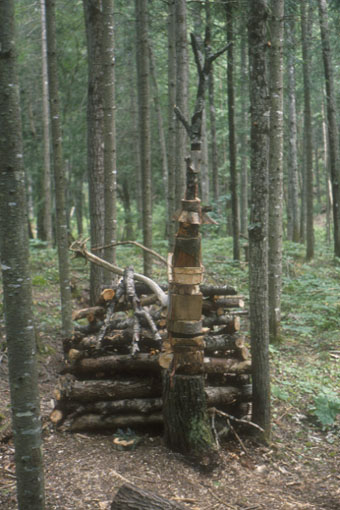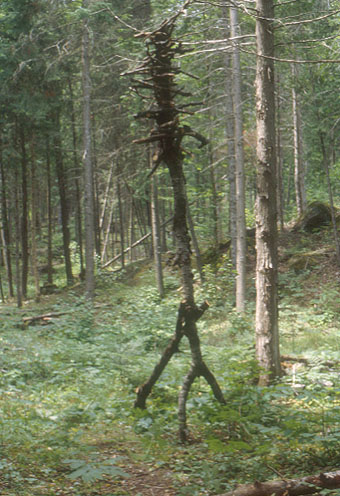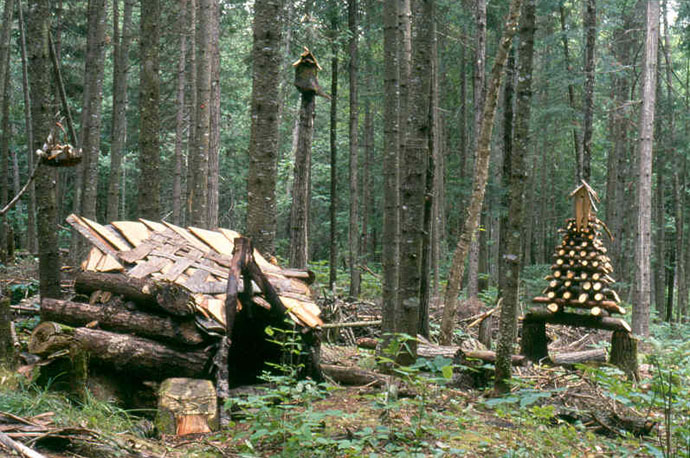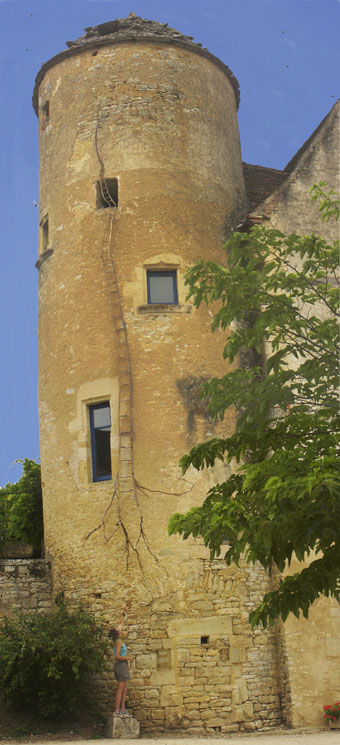
Walking the forest at Boreal Art & Nature, I observed its beautiful condition and realized it did not need my assistance. To look deeper, or more widely, we arranged to meet with a ranger at a nearby wildlife reserve to ask about the largest problems facing wildlife in this part of Quebec. He said the biggest problem was money, often in the form of destruction of habitat for short-term financial gain. His primary example was the timber industry. To our surprise, he said that even the local landmark Mount Bondy, within the reserve, was scheduled to have 30% of the timber cut. Other people had already told me logging was a local concern, an issue between preservation and economy.
The information from the interview set off a local protest and an ongoing effort to stop the cutting of this section of the Rouge River valley’s “patrimony”, with meetings, petitions, and letters to ministers. In the meantime, I realized I wanted to create an artwork about destruction by logging the boreal forests and the loss of habitat for the species who share the place.
I wanted to find a “cut” area and use the leftover waste material to bring the place back into use for other species. This was not easy in our forest because Luc manages the forest with great care, cutting only in sustainable and selective ways. I found one place where he had been thinning out poplar and some small fir to make room for the larger spruce. There were stumps, piles of cut logs, and slash piles of smaller branches. I used materials mainly from the site and some from Luc’s sawmill and fallen debris in the rest of the forest to create:
It came to me that the piece could be expanded into the rest of the forest as The Mystery, the Evidence, and the Small Atonements. The mystery one senses on entering the forest environment is partly the feeling that it is a place not dominated by human activity, that other lives are in process. The evidence of those lives is pointed out by small twig frames around places where we can observe traces of those lives, and a few places where I consistently encountered other species. By a rock wall along the trail a wren sang most mornings; at my site a squirrel came through several times with her mouth full of nesting material; as I worked I learned the sound of termites chewing logs. The small atonements are the sculptures which contribute to habitat disturbed or destroyed by timber harvesting. Evidence frames are concentrated near the beginning of the trail, at my atonement site and around the beaver lake, with a few others scattered along the trail.
Sharing The Birds Of Quebec
During my time at Boreal I have been observing birds and trying to identify them, and asking local residents about some of the birds here during other seasons. This research is part of another project, Migration Mileposts, in which I am creating markers to link communities which share migratory birds, tracing some species journeys on migration. It is difficult to get data on small songbirds, and I found the records of the Canadian Atlas Of Bird Banding and its website to be invaluable. Some of the species observed, their possible range and the documented travels are listed below.


Reconstructed Tree – Art/Nature Boreal, Quebec, Canada, 2002. Photo: Lynne Hull
Lynne Hull

| Migration Mileposts | ||
|
Species |
Range |
Records |
|
Chimney Swift |
To S. Colombia |
Memphis, TN/Ochlocknee, GA |
|
Kingfisher |
To Mexico, Colombia, West Indies |
Delaware Bay, NJ |
|
Philadelphia Vireo |
To Panama |
Guatemala |
|
Barn Swallow |
To South America |
Lassets Island, MA; Island Beach, NJ |
|
Eastern Bluebird |
Central America, Cuba |
NY, GA; Lake City, FL |
|
Cedar Waxwing |
To Panama, Antilles |
AL, FL, OR, Guatemala |
|
Nashville Warbler |
Mexico, Guatemala, Belize |
Muskegon, MI |
|
Magnolia Warbler |
Mexico, Panama, Cuba |
NJ, Honduras |
|
Black & White Warbler |
TX, FL, Mexico |
VT, NJ; Punta Gorda, Belize |
|
Pine Siskin |
to Mexico |
ME, VA, PA, TX |
|
Chipping Sparrow |
Southern Mexico |
Island Beach, NJ; SC, FL |
|
Song Sparrow |
Southern US |
VA, KY, FL |
|
American Goldfinch |
Mexico, FL |
MA, VA, FL |
|
White Throated Sparrow |
Southern US |
MD, NC, SC, GA, TX |
|
Common Redpoll |
Into Arctic |
NJ, SD, Alaska |
|
Evening Grosbeak |
Southern US, FL |
|
|
Rose Breasted Grosbeak |
Mexico, Venezuela, Colombia, Ecuador, Peru |
|
|
Great Crested Flycatcher |
South FL, Mexico, Central America, Colombia, Venezuela |
|
|
Eastern Phoebe |
FL, to Veracruz & Oaxaca, Mexico |
|


L’échelle entre La Dame Blanche et L'Homme – Les Arques, France. 2003. Photo: image-world
Lynne Hull is a “trans-species” artist, creating ecologically based sculpture and installations which are useful to wildlife, are created as part of wildlife habitat restoration, and expand human awareness of the needs of wildlife.
These recent projects in France and Quebec, as well as her current work with migratory birds, are featured on her revised and updated website at www.eco-art.org.
Appendix: Species exchange details
Principles for the Trans-species Cultural Exchange at Les Arques, France, April 2003
Species Exchanges at Les Arques artist residency
Back to top